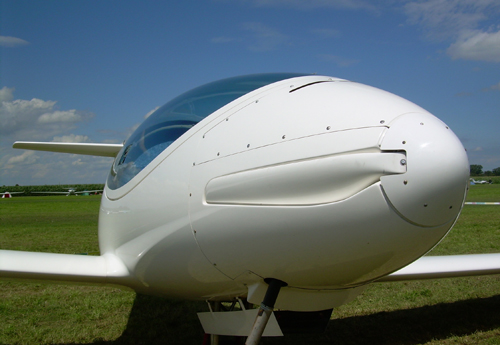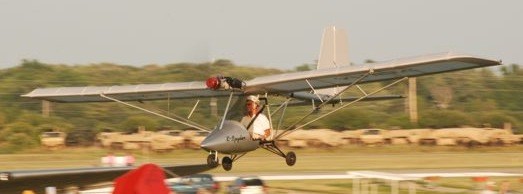Shanghai-based Yuneec, already promoting a line of electric paramotors, an electric trike, the two-seat E430, unveiled at last year’s AirVenture, and a series of motor/controller/battery combinations, has added to their offerings at AirVenture 2010.
New craft include two aircraft, the Apis 2 and Viva from Martin Wezel Flugzeugtechnik, a German designer and purveyor of sailplanes and light sport aircraft.
The Apis 2 is a derivation of the Silent electric sailplane, and in this application will be powered by a Yuneec motor system. The Viva, a two-seat motorglider, was designed originally for an HKS-700E two-cylinder engine of about 60 horsepower, and will be converted, like the Apis, to Yuneec power.
Spanning 15 meters (49.2 feet), the Apis 2 has a best lift-to-drag ratio of 39:1 at 95 kilometers per hour (59 miles per hour). Normally fitted with a Hirth F33 two-stroke engine of 27 horsepower, the sailplane is self launching and carries 14 liters of fuel, enough for about an hour-and-a-half of cruising on power. Apis 2 has a minimum empty weight of 210 kilograms (462 pounds) and maximum loaded weight of 320 kilograms (704 pounds). Yuneec’s version should come close to matching these weights.
The Viva has a 17-meter (54.4 feet) wingspan and can attain a best lift-to-drag ratio of 40:1 at 100 kilometers per hour (62 miles per hour). With an empty weight of 297 kilograms (653.4 pounds) and an all-up weight of 472.5 kilograms (1039.5 pounds) in its internal-combustion version, Viva’s 121-pound engine and 40 liters of fuel could be replaced by a lighter electric motor and equivalent batteries to give self-launching and retrieval capabilities, along with a splendid view of the world below. According to Experimental Aircraft Association news, the electric Viva will sell for $99,995, about the price for its HKS-powered version.
The propeller, a Wezel design, folds into cooling slots in the sides of the fuselage, much like the Front Electric Sustainer design by the Znidarsics.
Introduced at last year’s AirVenture, Tom Peghiny’s e-Spyder ultralight has been lightened, had its span lengthened, and now has twice the battery capacity of last year’ aircraft It is claimed to be a true Part 103 ultralight and is priced at $27,995.
The E430 has been modified with removable wing tips, reducing the tipless span to 38 feet, and allowing its entry into standard T-hangars. Price of the E430 continues at $89,995.
Yuneec promotes what it calls a “plug in and fly” motor/controller/battery system in four power outputs; 10 kW (13 horsepower), 20 kW (27 horsepower), 40 kW (54 horsepower), and 60 kW (81 horsepower). Weights range from a mere 4.5 kilograms (10 pounds) for the smallest unit to 30 kilograms (66 pounds) for the largest. The two smallest motors generate their maximum power at 2,400 rpm, or can be ordered as + models, achieving maximum output at 2,000 rpm. The two larger motors achieve maximum output at 2,400 rpm.
Power Block controllers are matched to their specific motors, and batteries are available in 30-Amp or 100-Amp modules. 30-Amp modules weight 12.8 kilograms (28.2 pounds) and 100-Amp modules weight 83.5 kilograms (188 pounds). Chargers are matched to the two different module sizes.
With these introductions, Yuneec is positioned to serve light flyers from paramotors to electrified motorseglers. Yuneec and FAA officials are apparently still working out details as to whether the Apis and Viva will be Light Sport Aircraft or self-launching sailplanes, of importance to how they and their prospective pilots will be licensed. Once the bureaucratic nuances are settled, Yuneec has a complete range of light aircraft and motors from which to choose.



